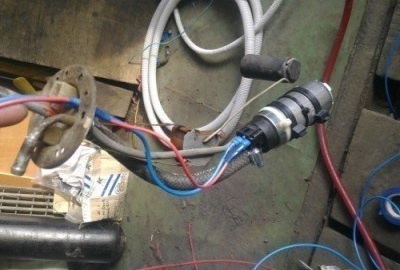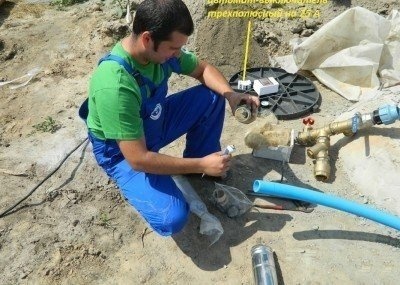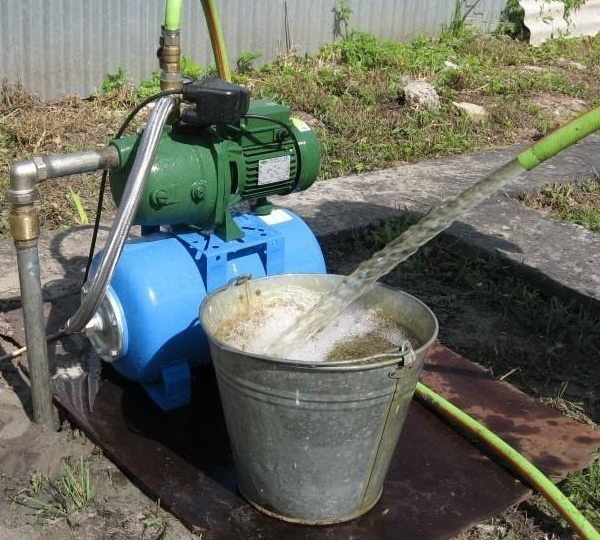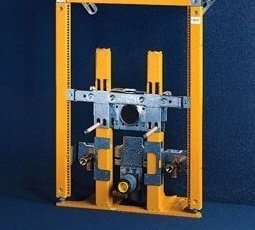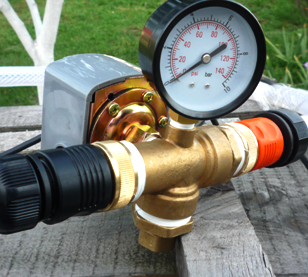Installation of a pump in a well: technology of self-assembly and replacement in case of repair
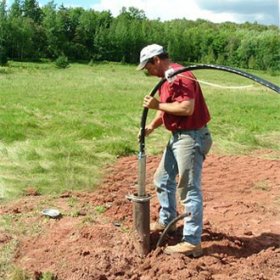
Citizens with great joy change their residence permit: becoming a resident of a suburban village is both pleasant, prestigious, and good for health. True, such a change in habitat means that interruptions in electricity and walking with a bucket of water for most immigrants will become familiar realities. You can put up with it, but you can fight. To buy and install the same generator, you need very little time. But with a source of water, everything is much more complicated. It’s difficult to find a place for a well yourself, but digging it is generally life-threatening. It is best to contact the specialists who will do the work for you. They will say whether it is possible to drill and install a pump in the well at the site, if this option is more suitable for you.
Content
Rules for installation and commissioning
Before you install the pump in the well, you need to check for any irregularities, curvature or narrowing of the casing. All this can not only significantly complicate the installation, but also reduce the life of the equipment. If the difference in the diameters of the pipe and the pump is too small, all surface defects will affect its operation; if it is too large, the pump may burn out. The fact is that in the latter case, the water velocity, which is necessary for cooling the engine, will not be provided. The minimum permissible values should be indicated in the technical documentation.
The pump is suspended on a nylon cord capable of withstanding a tensile load that is five times its weight. To avoid suction of the node on which the suspension is fixed, it is tied at a distance of at least 10 centimeters from the inlets, and its ends are melted. If the pump is lowered less than ten meters, an additional spring suspension must be attached to the end of the cord to dampen the vibration. This may be a medical tourniquet or flexible rubber tape.
Do not use an iron wire or cable as a suspension, since they break the mounts on the aluminum pump housing during operation.
The power cord, kapron suspension and metal-plastic pipe are fastened with electrical tape with a step of 70-130 centimeters. The first ligament should be at least 20-30 centimeters from the pump nozzle.
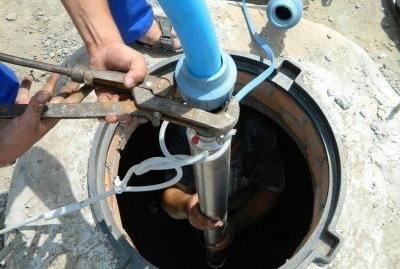
The pump suspension is selected in such a way that it can withstand a load that is 5-10 times the weight of the pump. And the mount should be ten centimeters from the inlets
Connecting the pump to the well does not imply the use of threaded connections. They reduce the strength of pipes, corrode. Flange connections will last much longer.When using them, the fixing bolt must be inserted from above, and the nut from below, since a bolt that fell into the well can lead to a serious accident.
The upper end of the discharge pipe is attached to the base plate. Then, a check valve is installed on it (if it is not on the pump), a valve, an elbow, a pressure gauge, and equipment is connected to the water supply system.
Next, the suspension should be attached to the crossbar. This is the last thing to do before lowering the pump into the well. When lowering it should not touch the walls. If this cannot be guaranteed, the case is better protected with a rubber ring.
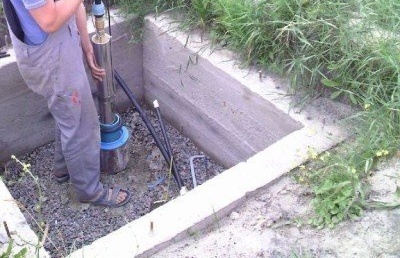
The pump must be lowered into the well very carefully, avoiding contact and impacts against the walls. Just in case, you can put a rubber ring on the case
In order to measure the water level in the well, a column of gas pipes is installed in the hole of the base plate. It is submerged below the dynamic level.
Megger need to determine the insulation resistance of the motor winding with the cable down. After that, the control station is connected to the pump, it is checked whether it is sufficiently immersed in water and the operation of the electric motor under load is evaluated.
To what depth can and should the pump be lowered?
The static level is the length of the segment from the ground level to the water mirror in its natural state. Then, water is pumped out of the well. The level at which the water stops is called dynamic.
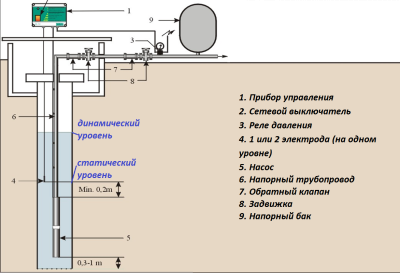
The pump drops two meters below the dynamic water level, and at least one meter should remain at the bottom of the well
In order for the engine to cool properly, lower the pump to a mark of at least 30 centimeters below the dynamic level, and diving two to three meters below this mark is considered optimal. It should be remembered that the distance to the bottom of the well should be at least 1-2 meters.
How to replace the pump in the well in case of an accident?
The need to replace the pump rarely occurs, mainly due to the fact that the pump was not properly installed in the well. The cause of the accident may lie in the improperly selected power automation, and in the low power of the pump itself. For example, if it is designed for a 50-meter dive, but is actually installed at a depth of 80 meters, then repairs will be needed in a few months.
Power automation is set to working water pressure, and from such a depth a weak pump simply cannot lift it. As a result of constant work without shutdown, it quickly breaks.
As in any situation, there are two ways out: we call repair specialists or we do everything ourselves.
Option No. 1: we call specialists for the repair of deep pumps
This option is primarily suitable for those who are not versed in pumping equipment. Professionals can objectively assess the situation, identify the causes that led to equipment malfunctions. It is possible that only the automatic power supply is working incorrectly, and the pump itself is in working condition. In this case, it is enough to properly configure it.
Another plus for those who have already decided that such a repair is beyond his power, is the guarantee that the contractor gives. Also, in addition to the main work, you will complete the complete setup of the entire water supply system. Of course, you need to pay for such services, and if we are talking about replacing the pump, then the amount will be impressive.
Option number 2: do-it-yourself pump replacement
On your own, the replacement of the pump in the well is carried out only if you are sure of its malfunction. If in doubt, it is better to contact a specialist.
This work alone is simply impossible, at least five more people will need help: at a 100-meter depth, a pump with cable and suspension weighs about 250 kilograms.
- First of all, you need to prepare a bench tool, an electric soldering iron, a building hair dryer, a heat shrink sleeve, scissors and supplies.
Then we disconnect the wellhead pipeline and the pump power cable from the main house going to the house. After this, we unscrew the lingering element.
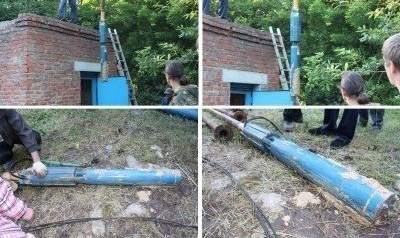
When lifting the pump, a safety cable must be used. If the pump breaks, it will be impossible to raise it, and therefore to use the well in the future too
- Raised to the surface, the pump is disconnected from the line.We carry out inspection of the pump, if nevertheless it is in working condition, we replace the connecting mechanism, the coupling and the non-return valve. The old ones, most likely, have already lost their working properties, so it is better to put new ones. If the previous pump cannot be repaired, install a new one.
- Next, we connect the pipeline main to the pump, solder the power supply cable, remembering the tightness of the connection and the shrink sleeve. We attach a safety cable, check its tension.
- Installation of a downhole pump in a well should be carried out extremely carefully. It is undesirable to allow contact with the walls of the casing.
- We tighten the borehole head, attach the fittings to the harness and configure the automation in accordance with the specified parameters.
The most convenient option for organizing water supply in a suburban area is a well. The downhole pump works quietly, and if the installation and commissioning were done correctly, then the next time you will have to look into the well very soon.
